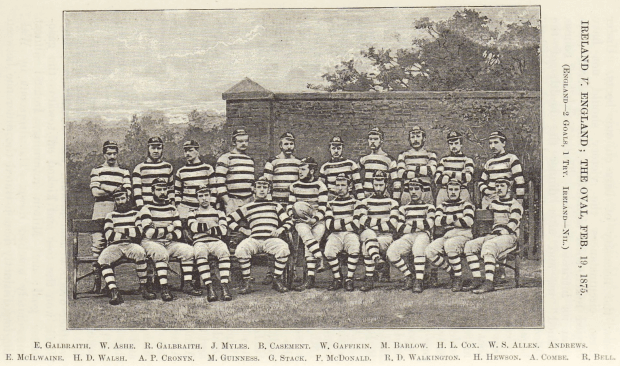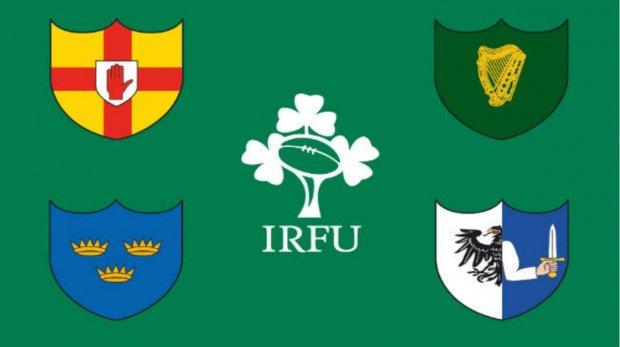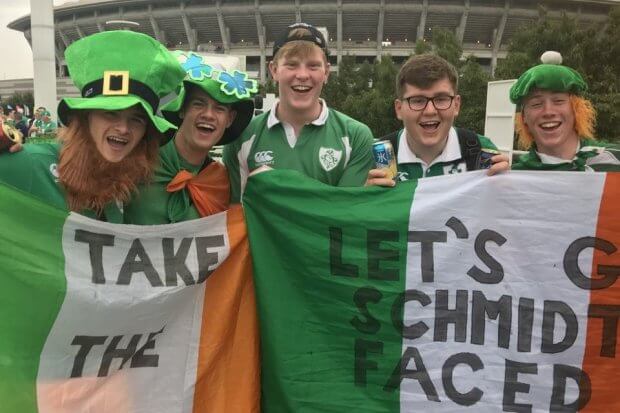By Guest Writer “AussieIrish”
With Part I, and the subsequent conversations that took place in the chat (thanks to all who took part), hopefully you now have a bit of an idea of both the geography and the complexity of the politics that impact on rugby on this beautiful island of Ireland. Please note that while I’m doing what time permits to validate the facts within the article, as with everything these days, opinions and perspectives may vary. Feel free to offer alternative opinions, and so ‘add to the mix’ in the comments below. I really liked the description from Who? in the comments to Part 1, of this being “an impressionist’s approach” to story-telling.
With that, back to the story at hand…
While the first international played by Ireland is generally accepted as being on 19 February 1875 (a 7-0 loss against England), the Irish Rugby Football Union, the governing body for rugby in Ireland, wasn’t founded until 1879 following the amalgamation of the Irish Football Union (1874) and the Northern Football Union of Ireland (1875). The formation of the IRFU was a significant step in organising and formalising the sport. The establishment of the IRFU was intended to standardise the rules of rugby and promote the growth and development of the sport. This was the same purpose for the formation of the International Rugby Football Board (IRFB) by Ireland, Scotland, and Wales in 1886.

Following the war of independence and partitioning of Ireland in 1921 the IRFU agreed to continue to operate on a united basis to represent all 32 counties and 4 provinces as they had done prior. This led to the situation today where the Irish rugby team is comprised of representatives of the two countries. As is the want in Ireland, politics came to the fore with questions such as “what anthem shall be played?” and “what flag should be flown?”. Initially it was agreed that no anthem should be sung at Irish international matches and to use an IRFU flag.
In the 1930s it was agreed to use the anthem of the Republic of Ireland “Amhrán na bhFiann” (The Soldier’s Song) at matches in the Republic of Ireland, “God Save the King” at those played in Northern Ireland, and no anthem at away matches. Even this caused issues with Republic of Ireland players in 1954 refusing to take the field until after “God Save the Queen” was finished. This, little, disagreement resulted in no senior Irish international matches being played in Northern Ireland from 1954 until 2007. It took until 1995 World Cup to resolve the matter when the IRFU commissioned a new anthem (Ireland’s Call) and use the IRFU flag.
It was highlighted by my wife that on the cover of Part I the Republic of Ireland tricolour was shown, which as we all now know, does not represent Irish rugby. All I can say is that fortunately it wasn’t the Cameroon flag which is another common mistake!

Until the mid-1990s amateurism defined the sport across Ireland, with players dedicating their time to rugby alongside their professional careers. The amateur era saw rugby in Ireland flourish at the grassroots level with clubs being the lifeblood of the sport. Today with there are still over 200 clubs spread across the island.
Interprovincial matches, between Munster, Leinster, Ulster and Connacht, have been pivotal in shaping Irish rugby’s landscape. These contests showcased the best talent from each province and ignited a sense of regional pride. The fierce rivalries and passionate supporters laid the foundation for what would later become professional competitions. From everything that I’ve seen and experienced while here, Irish rugby is all about the grassroots. How this works in practice is as follows:
- Schools rugby has historically played a pivotal role in Ireland, serving as a crucial breeding ground for developing talent and fostering a deep connection to the sport. The significance of schools rugby is evident in several key aspects.
- Player Development Pathway: Schools rugby forms an integral part of the player development pathway in Ireland. Many of the country’s top rugby players emerge from school programs, showcasing their skills at the underage levels before progressing to club and provincial teams.
- Traditional Competitions: Prestigious schools competitions, such as the Leinster Senior Cup, Munster Senior Cup, Ulster Schools Cup, and Connacht Schools Cup, are steeped in history and tradition. These competitions provide a platform for schools to compete at a high level and are followed passionately by students, alumni, and the wider rugby community.
- Coaching and Development: Schools often have dedicated rugby programs with qualified coaches. These coaches play a crucial role in the development of players, focusing not only on skill acquisition but also on instilling values such as teamwork, discipline, and sportsmanship. The coaches will be guided and supported by both the province and IRFU.
- Community Engagement: Schools rugby has a strong community focus. Matches draw enthusiastic crowds, creating a sense of camaraderie and school spirit. This community engagement helps in building lifelong connections between individuals and their alma maters.
- Cultural Significance: Schools rugby holds cultural significance in Ireland. The annual schools competitions are major events on the rugby calendar and attract widespread attention. The historical rivalries and iconic moments from these competitions contribute to the rich tapestry of Irish rugby culture.
- Character Development: Beyond the technical aspects of the game, schools rugby emphasises character development. Students learn valuable life skills such as leadership, resilience, and teamwork, which extend onto and beyond the rugby field.
For the last 18 years I’ve lived in a nice part of south County Dublin. It’s about the equivalent of Sydney’s North Shore, with pretty much every kid going to a fee-paying school. One of the most common conversations that you will hear in a pub involves the age old question of what school you went to and did you play rugby. While I heard these questions often enough back in Australia, what has stuck me as being a little different, is that inevitably the person asking the question will start re-living some story about how they played a significant role in a school’s cup 40 odd years ago. I didn’t quite understand this, but I gained a better understanding when I went to a Leinster Senior Cup final. 18,000 people cheering on the two teams, broadcast on national television, and generally incredible rugby. It really was something to behold (see below)
While less than 50% of the professional Irish-born professional players attended a fee-paying school (Role of fee-paying schools in Irish rugby only half the story – The Irish Times) with the non-fee paying schools (36%) and foreign born players (18%), it should be highlighted that less than 8% of secondary students are educated in a fee-paying schools, which demonstrates the impact that this small population have on Irish rugby ( https://www.irishtimes.com/ireland/education/2023/08/21/private-school-numbers-climb-to-highest-on-record/)
Beyond the schools are the clubs in Munster, Leinster, Ulster, and Connacht that form the foundation of club rugby. The club rugby structure includes multiple divisions, allowing for promotion and relegation between them. In addition to senior-level competitions, youth and mini rugby are crucial components of the club structure. Clubs typically have extensive youth development programs, nurturing talent from a young age and promoting a pathway to senior rugby. When my son was 7, I enrolled him in the local junior club. And in that club alone there were ~60 kids enrolled and ~15 club coaches. Once again, every coach had undergone training via Leinster and IRFU with two Leinster branch development coaches on hand to oversee proceedings.
Interesting enough, there was no national league in Ireland until 1991, when after almost five years of discussion and consultation with clubs, the All-Ireland League (AIL) was introduced. Prior to this there were leagues and cup competitions operated by the individual provincial administrations. This structure continues to this day as the structure beneath the AIL. The AIL serves as the top tier of club rugby in Ireland and is divided into four divisions (1A, 1B, 2A, and 2B) with promotion and relegation between the divisions, fostering competitiveness.

Potential national talent can be identified at any level within the system and the IRFU have a pathways program to assist with talent development (Irish Rugby | Opportunities). As in most sports, home-grown talent is generally identified in the junior ranks (schools or clubs), with these players quickly being lifted into the provincial academies. While being on the books of the academies, the player will still run out for their schools as well as junior representative sides. All going to plan a player will break into the provincial team and be given a professional contract before moving on to further representative honours.
While playing for schools, players are generally discouraged/not permitted to play for clubs. Once given a professional contract, clubs are limited in how many professional players they can play. It is only after players have finished school and/or have missed out on a provincial contract that they can go back the clubs.
There are a couple of issues with this structure with players developing at different ages. If the player is on the fringe of a schools team their opportunities for game time will be limited, yet they are still not released to the clubs. The schools are also so focussed on the schools cups there is a massive investment in the first team, but this quickly drops away for players in the lower grades. This can result in a slowing of the player development and/or the player losing interest in the game. When the player leaves school the connection with the club is broken and/or the player moves on with their lives. Ultimately the clubs struggle to attract and retain youth talent members do their best to keep things going.
That’s it for this now. In Part III I’ll dig a bit deeper into the Irish sporting landscape and the competition that exists, the structure of the IRFU, coaching, referee and, professional player development.
Feel free to comment away below…

